ROME – Hard cases, as the famous legal maxim holds, make bad law. The Vatican served up a reminder of the point this week with a new “little end-of-life lexicon,” which not-so-subtly amends an earlier Vatican ruling on the issue of withdrawing artificial nutrition and hydration from chronically ill patients 17 years ago.
The new lexicon was issued by the Pontifical Academy for Life, and while it doesn’t have the force of law or express any new teaching, it nevertheless clearly marks a departure from the position taken by the Vatican in 2007, which was framed in the wake of the anguished Terry Schiavo case in the United States.
The lexicon, by way of contrast, so far has been issued only in Italian, and doesn’t appear linked in a direction fashion to any current high-profile case.
Though it may be difficult to remember now, the Schiavo case was perhaps the most notorious, and controversial, end-of-life debate in the United States throughout the late 1990s and early 2000s. It became a political football during the 2004 election, in part because it was unfolding in Florida, a premier presidential battleground state, which at the time was governed by Jeb Bush, the brother of President George W. Bush.
To recap, Terry Schiavo went into cardiac arrest at her home in St. Petersburg, Florida, in 1990, experienced massive brain damage, and was eventually diagnosed as being in a persistent vegetative state. For the next several years various therapies were attempted without a favorable result, and in 1998, Schiavo’s husband decided to remove the feeding tube which was keeping her alive.
That decision was immediately challenged by Schiavo’s parents, Robert and Mary Schindler, who, among other things, insisted that Schiavo was a devout Roman Catholic and would not have wished to defy church teaching, including the idea that withdrawing food and water from a patient is tantamount to a form of euthanasia.
The clash between husband and parents triggered an explosive legal and political debate which played out for the next seven years, until the feeding tube was definitively withdrawn and Schiavo died on March 31, 2005. The case aroused wide and passionate Catholic activism, often driven less by the church’s official leadership than by a sprawling, informal horizontal network of pro-life activists and movements.
Now ex-priest Frank Pavone, head of Priests for Life, delivered the homily at Schiavo’s funeral Mass on April 5, 2005 – which, as things turned out, was just four days before the death of Pope John Paul II on April 9.
(Though it’s just a footnote now, Catholic interest in the Schiavo case was briefly amplified by the coincidence that she died just as John Paul entered the final phase of his own illness, and for a time, he too was being provided nutrition through a feeding tube. In the hothouse atmosphere of the moment, even that act was seen by some as having political significance, as if John Paul was somehow offering a rebuttal to Schiavo’s husband.)
In the aftermath of the Schiavo affair, the bishops of the United States submitted two dubia, or formal questions, to the then-Congregation for the Doctrine of the Faith, the responses to which held in principle that the provision of food and water to a patient in a persistent vegetative state, even using artificial means, represents “ordinary and proportionate care” and may not be withdrawn, even if physicians have determined the patient will never recover.
As the new lexicon notes, that 2007 response did include an important qualification, stating that artificial nutrition and hydration is obligatory “to the extent to which, and for as long as, it is shown to accomplish its proper finality, which is the hydration and nourishment of the patient.” In other words, if the patient’s body is no longer able to assimilate the food and water being provided, then it can be withdrawn.
Nonetheless, that 2007 answer clearly cut in the direction of a quasi-absolute rejection of withdrawing artificial nutrition and hydration in most cases.
The American context of the conclusion is underscored by the coincidence that when the dubia were submitted by the Committee on Doctrine of the U.S. bishops’ conference in July 2005, immediately after Schiavo died, the chair of that committee was Cardinal William Levada of San Francisco. By the time the replies came two years later, Levada was the Prefect of the Congregation for the Doctrine of the Faith under Pope Benedict XVI, which meant, in effect, he was in the position of answering his own questions.
At the time, the Schiavo case seemed to pose a choice between appeasement and battle, between accepting a first step along a slippery slope towards euthanasia and even a “duty to die,” or drawing a clear line in the sand in defense of human life and the inherent dignity of every person, no matter their physical condition.
Today, with 17 additional years of both clinical and pastoral experience, it’s perhaps easier to accept that things aren’t always so black-and-white, and that there’s room for differing judgments in concrete cases. Most particularly, it’s almost certainly less fraught to have the conversation without a media and political hurricane unfolding in the background.
In that sense, perhaps the Vatican’s evolving position on artificial nutrition and hydration offers an inadvertent reminder that for every time Rome gets in trouble for dragging its heels and “thinking in centuries,” there’s an equal-and-opposite danger in answering too quickly – especially when the response is shaped more by the pressures of the moment than by the wisdom of perspective.















